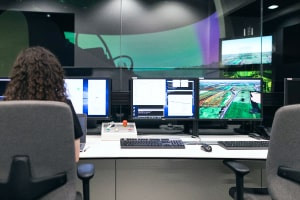The practical approaches to detecting and establishing feature correspondence across different images all originate with the conceptual idea of detecting edges on an image, using various mathematical methods. As you begin this course, you explore how detecting edges by changes in direction, intensity or colour is the first step in recovering information from images. You will be taught how the circularly symmetric feature of Laplacian of Gaussian is used for detecting the regions of an image in which some properties are constant. Alongside this, how the corner detection method is used to extract information about the features and infer an image’s contents is also described. Other methods for detecting various kinds of edges and blobs in an image are also highlighted.
Next, the course illustrates the Harris Corner Dectector’s scale-invariant nature by analysing the images’ key points at different scales. Discover the image pyramids’ role in performing tasks such as image blending and coarse-to-fine correspondence search to accelerate certain operations. This includes analysing the specific frequency content in the image in particular directions in a localised region around the point or region of analysis. The role of the scale-invariant feature transform in modifying the image data into scale-invariant key point co-ordinates is discussed. Learn about the process of extracting and matching the key points with their corresponding locations in the images. The scale-invariant features are formed by computing the gradient at each pixel in a window around the detected keypoint, using the appropriate level of the Gaussian pyramid.
Finally, the material highlights the various techniques that have been developed for image segmentation. These include algorithms based on active contours and level sets, region splitting and merging, mean shift, normalised cuts, and binary Markov random fields solved using graph cuts. In addition, representing an image in terms of clusters of pixels that belong together for locating objects and boundaries in images, is discussed. Discover how the shape context and maximally stable extremal regions are used for recognising objects based on their contours and for applications that require affine invariance. Lastly, the course explains how the human visual system interprets the subtle variations in transparency and shading in the images by correctly segmenting the object from its background. ‘Computer Vision - Visual Features and Representations’ is an informative course that will interest those studying computer science or involved in industries with self-driving cars, packaging and quality monitoring, 3D maps, motion estimation and many others.
What You Will Learn In This Free Course
View All Learning Outcomes View Less All Alison courses are free to enrol, study, and complete. To successfully complete this Certificate course and become an Alison Graduate, you need to achieve 80% or higher in each course assessment.
Once you have completed this Certificate course, you have the option to acquire an official Certificate, which is a great way to share your achievement with the world.
Your Alison certificate is:
- Ideal for sharing with potential employers.
- Great for your CV, professional social media profiles, and job applications.
- An indication of your commitment to continuously learn, upskill, and achieve high results.
- An incentive for you to continue empowering yourself through lifelong learning.
Alison offers 2 types of Certificate for completed Certificate courses:
- Digital Certificate: a downloadable Certificate in PDF format immediately available to you when you complete your purchase.
- Physical Certificate: a physical version of your officially branded and security-marked Certificate
All Certificate are available to purchase through the Alison Shop. For more information on purchasing Alison Certificate, please visit our FAQs. If you decide not to purchase your Alison Certificate, you can still demonstrate your achievement by sharing your Learner Record or Learner Achievement Verification, both of which are accessible from your Account Settings.











 Avg. Hours
Avg. Hours  Contains Video
Contains Video  CPD Accredited
CPD Accredited 
 Total XP:
Total XP: 
 Knowledge & Skills You Will Learn
Knowledge & Skills You Will Learn 







